The global death toll from the coronavirus eclipsed 1 million Monday, according to a tally from Johns Hopkins University.
Nine months after the COVID-19 pandemic struck, devastating global economies, pitted science against politics, changed the way companies work, and impacted the way people live their lives for years to come, governments are scrambling to contain the virus and scientists around the world race for a vaccine.
With over 200,000 deaths, the United States leads the global death toll, followed by Brazil (over 142,000), India (over 95,000), Mexico (over 76,000), and the United Kingdom (over 42,000). The U.S. accounts for approximately 1 out of 5 coronavirus deaths worldwide, despite America’s wealth and medical resources.
The bleak milestone is greater than the population of Jerusalem or Austin, Texas. It is 2 1/2 times the amount of people who attended Woodstock in 1969. More than four times the number killed in the 2004 earthquake and tsunami in the Indian Ocean.
Even then, the figure is almost certainly a vast undercount because of inadequate or inconsistent testing and reporting and suspected concealment by some countries.
And the number continues to mount. Nearly 5,000 deaths are reported each day on average. Parts of Europe are getting hit by a second wave, and experts fear the same fate may await the U.S.,
The virus first appeared in late 2019 in patients hospitalized in the Chinese city of Wuhan, where the first death was reported on Jan. 11. By the time authorities locked down the city nearly two weeks later, millions of travelers had come and gone. China’s government has come in for criticism that it did not do enough to alert other countries to the threat.
Government leaders in countries like Germany, South Korea and New Zealand worked effectively to contain it. Others, like U.S. President Donald Trump and Brazil’s Jair Bolsonaro, dismissed the severity of the threat and the guidance of scientists, even as hospitals filled with gravely ill patients.
The virus has forced trade-offs between safety and economic well-being. The choices made have left millions of people vulnerable, especially the poor, minorities and the elderly.
With so many of the deaths beyond view in hospital wards and clustered on society’s margins, the milestone recalls the grim pronouncement often attributed to Soviet dictator Josef Stalin: One death is a tragedy, millions of deaths are a statistic.
The pandemic’s toll of 1 million dead in such a limited time rivals some of the gravest threats to public health, past and present.
It exceeds annual deaths from AIDS, which last year killed about 690,000 people worldwide. The virus’s toll is approaching the 1.5 million global deaths each year from tuberculosis, which regularly kills more people than any other infectious disease.
But “COVID’s grip on humanity is incomparably greater than the grip of other causes of death,” Lawrence Gostin, a professor of global health law at Georgetown University, told the Associated Press. He noted the unemployment, poverty and despair caused by the pandemic, and deaths from myriad other illnesses that have gone untreated.
For all its lethality, the virus has claimed far fewer lives than the so-called Spanish flu, which killed an estimated 40 million to 50 million worldwide in two years, just over a century ago.
That pandemic came before scientists had microscopes powerful enough to identify the enemy or antibiotics that could treat the bacterial pneumonia that killed most of the victims. It also ran a far different course. In the U.S., for example, the Spanish flu killed about 675,000. But most of those deaths did not come until a second wave hit over the winter of 1918-19.
Up to now, the disease has left only a faint footprint on Africa, well shy of early modeling that predicted thousands more deaths.
But cases have recently surged in countries like Britain, Spain, Russia and Israel. In the United States, the return of students to college campuses has sparked new outbreaks. With approval and distribution of a vaccine still probably months away and winter approaching in the Northern Hemisphere, the toll will continue to climb.
“We’re only at the beginning of this. We’re going to see many more weeks ahead of this pandemic than we’ve had behind us,” Gostin said.
The Associated Press contributed to this report.



